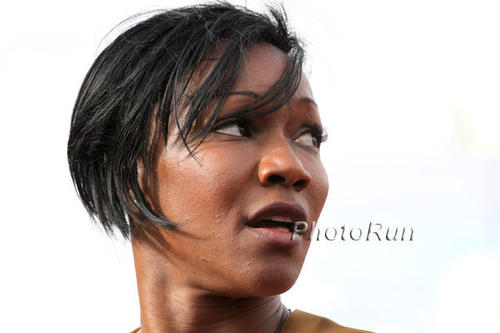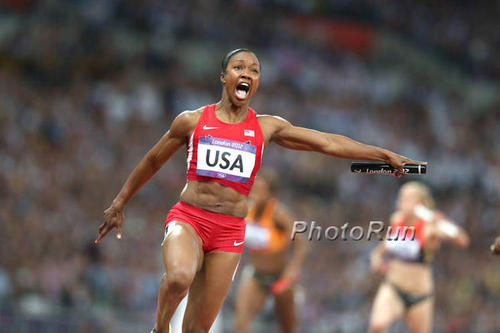Carmelita Jeter is not only fast, but enduring. I can close my eyes and see her face and reaction to the WR in the 4×100 meters in the 2012 London Olympics. Now, four years later, Carmelita is focusing on the 2016 Olympic Trials and the Rio Olympics.
Here is David Hunter’s fantastic story on the sprinter who has endured through injuries, rough races to win three Olympic medals in 2012. The road to Eugene is a few weeks away and less than two months for Rio.
And Carmelita Jeter is focused.
 Carmelita Jeter, photo by PhotoRun.net
Carmelita Jeter, photo by PhotoRun.net
Carmelita Jeter: Fastest Woman Alive
Decorated Sprinter Aspires To Be “People’s Champ”
Unless they’ve been living in a cave for the past four years, most American track & field fans can visualize in their mind’s eye the London Olympic Games and the enduring image of a driven Carmelita Jeter storming across the finish line in the women’s 4x100m relay final to capture the gold for the USA. Just past the line and still in full throttle, a wide-eyed Jeter instinctively points her baton to the infield clock – 40.82, a new world record.
 Carmelita Jeter, WR 4x100m, Her race was won! photo by PhotoRun.net
Carmelita Jeter, WR 4x100m, Her race was won! photo by PhotoRun.net
Reflecting back on that historic race and the moments that preceded it, Carmelita Jeter outlines how she and her teammates – Tianna Madison [now Bartoletta], Allyson Felix, and Bianca Knight – worked together in an unspoken way to create the pre-race poise, relaxation, and focus needed for success in an Olympic final. “Before the race, I was extremely happy. I was playing around with the other girls. Everybody was so relaxed. I was making them laugh. I was cracking jokes. I was having such a good time. And our energy was so calm, so peaceful, so happy,” Jeter recalls. “Our main objective was just to go out there and stop being called the team that can’t get the stick around. We were pretty tired of hearing ‘they can’t do this; they can’t do that.’ That gets frustrating. It gets even more frustrating when you hear it from Americans. Instead of hearing them pushing us for greatness, we kept hearing a lot of doubt. At that moment we – as a team – wanted to do what they said couldn’t be done: we wanted to get that stick around.” The team’s anchor smiles when reminded about the finish line image which is destined to be her photographic legacy: “It [the image] says a lot without saying a lot: We got the stick around and we broke a 27 year old world record.”
Like most world class athletes, the Southern California native can identify a particular life-affirming catalytic event that shaped her career in a positive way. For Jeter, it is not an instance of jubilation after a successful race or her union with a savvy and influential coach, but rather it is a sobering, teachable moment: a period of brutally honest introspection that followed her failure to make the 2008 Olympic team. “I basically said, ‘OK Carmelita, this is where you screwed up.’ Sometimes people are always willing to point the finger. They’ll say, ‘This person didn’t coach me right. And this person didn’t do this.’ Many times people aren’t mature enough to say, ‘I screwed up.’ A lot of people don’t want to take stock in themselves – it’s always somebody else’s fault. And 2008 was my fault,” admits Jeter. But the then-reigning World Championship 100m bronze medalist and 4×1 gold medalist and the World Athletics 100m champion knew what to do. “I put my big girl panties on and I said to myself, ‘This is your fault. You screwed up. You came into this with a big head. You went into this coming off of your medals in 2007 thinking that you were just going to get on this team.’ I acknowledged to myself that it took hard work in 2007 and I didn’t do that same hard work in 2008. And it was my fault,” Jeter offers with sincere candor. “And the change came from accepting that it was my fault and moving on.”
From that epiphany, Carmelita Jeter made thorough preparation her cornerstone – not just for sprinting, but for all aspects of her life. “It is not necessarily for track and field. Right now, I use it now for track and field, but my upbringing was always to try to be the best – always see the opportunity and take it. That’s how we were raised – always look for that opportunity and go and get it.” Harkening back to the 2013 Moscow World Championships where she battled her way through a seriously-injured thigh to capture the 100m bronze medal, Jeter adds, “If I see an inkling of an opportunity to be successful, to get a medal, to make a team, I’m going to pull a muscle to get it done.”
Combining engrained determination, natural talent, and a dash of John Smith training, Jeter has authored an impressive career of world-class sprinting that has spanned more than a decade. Along the way, The Jet has garnered 3 Olympic medals – one of each color – 8 world championship medals, 14 Diamond League victories, 4 national championship wins, and – of course – that world-record in the 4×1. While accomplished in the furlong [22.11 PR], Jeter’s 100m best of 10.64 [Shanghai, 2009] ranks her as the #2 performer on the all-time world list, behind only Florence Griffith Joyner – whose marks are often viewed with skepticism. Setting aside all of the speculation and shadowy uncertainty surrounding the legitimacy of the late FloJo’s clockings, one thing is clear: Carmelita Jeter is The Fastest Woman Alive.
Now an experienced and mature athlete at age 36, Jeter has added helpful elements to her training and life-style regimen that have enhanced the veteran sprinter’s ability to perform at the world class level. “So many things have changed. I am not ashamed to say I am 36. Sometimes as a woman as you get a little older, your body starts to change,” she notes. “One thing I’ve noticed is that my rear end and maybe my thighs wanted to get bigger than I needed them to be. So I learned that I can’t eat everything that I would eat 5 years ago. I just can’t eat burgers and be OK. I had to change some things. I do all organic meals now. So I’m cutting out all that fat and corn oil. So I am eating differently.” Having a sponsor that focuses on hydration also helps. “So I have tons of water now and I’m drinking more water than the law would allow,” she adds with a laugh. “I’ve added a couple of other things to my regimen: I’ve added karate; I go to Pilates. It’s allowed me to stretch a little more and keep my muscles more open. I also go to rehab and PT at Culver City. There were so many things I had to change – and not because I’m getting older – but because my body is changing. It is tough getting a little older. Everybody’s body changes and I have to change with it. I can’t expect my body to do the same things it did when I was 29 if I don’t change how to approach it.”
Witnessing older, high-performance track & field athletes – like 40 year old sprinter Kim Collins and 41 year old middle distance ace Bernard Lagat – has inspired Jeter – and others – to recalibrate the anticipated duration of track & field careers. “I know it is different because they are males. And I know the female body is different than the male body. I understand that,” prefaces Jeter. “But it does make me excited to see Bernard Lagat out there. It does make me excited to see Kim Collins still running very fast times at the age of 40. It makes me know that no one can put a number on what I can do,” she explains. “It makes me know I can’t get caught up in the hype of the sport – feeling like you have to be 25 to make it. I was 32 when I made the 2012 team! People thought that was impossible. I don’t think of myself as a 36 year old woman. I’m special. I know that. I don’t need anybody else to tell me that.”
She also doesn’t need anybody to tell her that Father Time is undefeated. She knows that. And that is why you see Jeter embracing this Olympic year. Feeding off the capacity crowd of over 40,000 at the Penn Relays earlier this spring, Jeter ran an electrifying anchor leg on Team USA’s winning 4×100 meter relay – giving no quarter to Jamaican anchor Shelly-Ann Fraser-Pryce who put nary a dent in Jeter’s lead coming down the homestretch. Was she sending a message to the Jamaican Pocket Rocket? “I wouldn’t say I was sending a message,” declares Jeter. “I’m an athlete who respects athletes. Let me put that out there. I don’t disrespect athletes because I actually have a résumé. When you’ve done great things, there is no need to be disrespectful. I respect Shelly-Ann Fraser for what she’s done for the sport; what’s she’s done for her country. So there’s no disrespect. Do I enjoy competing with her? Of course I do! She brings out the best in me. And I’m sure I bring out the best in her. We make each other step up our “A” games. Being out there was about running with my team and wanting to get a victory. At the end of the day, when you are running with three other women, it’s not about you. It’s about the country you are representing.”
The Jet feels no undue sense of urgency as she gets ready to compete next month for a place on what may well be her final Olympic team. “I’ve run three 100m races so far. And I ran 11.43 in Trinidad. In my second race, I ran 11.34 into a negative [headwind]. And then at Rabat, I ran 11.32 into a negative 1.3 [headwind],” notes Jeter in citing her unbroken early season progression. “If you are looking at the numbers, you’re thinking, ‘Jet’s not running fast.’ But I know I am not running as fast as people would probably like for me to run right now. Would I like to jump out there and run 10.9, 10.8, 10.7? Of course. But right now, my body is taking its time to get where it wants to get to. Am I fit? I’m extremely fit. You saw it at the Penn Relays. Every race is getting better. So mentally, I have to take and run with it. Every time I line up, I get closer to the finish line, my confidence is getting higher and higher, I am more patient, more secure. I don’t have to be ready until July.”
The 3-time 2012 Olympic medalist has an answer when asked how she would like to be remembered in the sport she loves. “I get asked that question a lot and I haven’t changed my answer. I want to be the remembered as the people’s champ,” explains the Fastest Woman Alive. “I want to be remembered as that person anybody can go up to at any time and speak with. I want to be remembered as down to earth. I want to be remembered as a great athlete, but also that person who is approachable.”
Jeter is far from thinking about bringing the curtain down any time soon on her celebrated career as a world class sprinter. But she’s happy to outline some of the many options she sees for herself after she hangs up her spikes. “After I retire, I’m not doing anything for six months – just travel and relax,” she laughs. “This has been my world for 11 years. I’ve been so focused, so determined, and have sacrificed so much that I’m going to take a break from the world. And after I do that, there are so many things that I would love to do that I can’t really put my finger on exactly which one I want to do,” explains Jeter. “I would love to commentate. I would love to one day be a coach at the college level. I have thought about maybe being an agent,” the sprinter speculates. “But I want to part of a broad community. I still want to be an activist in educating women and helping women and men in taking care of their bodies. And I still want to be what I am now: that person that goes to boys and girls classes and talks to the kids. I never had that. If you can go somewhere and talk to a child who would never otherwise meet you in their life, what impact can you have on them?” she asks. And after a momentary pause she adds, “I want to help somebody be the next Carmelita Jeter. I want to help somebody want to be better than what somebody else has already predetermined they can be.” Maybe even more than her unforgettable sprinting, that’s what just might make Carmelita Jeter the people’s champ.
Author

Dave Hunter is an award-winning journalist who is a U.S. Correspondent for Track & Field News. He also writes a weekly column and serves as Senior Writer for www.RunBlogRun.com, and covers championship track & field competition domestically and in such global capitals as Moscow, Birmingham, Zurich, Brussels, Beijing, Rio de Janeiro, Zagreb, Ostrava, and Doha. Hunter frequently serves as the arena or stadium announcer for championship track & field gatherings, including the Ivy League, the Big East, the Mid-American Conference, the NAIA, the Big Ten, and the Millrose Games. Hunter has undertaken foreign and domestic broadcast assignments. He ran his marathon P.R. 2:31:40 on the Boston Marathon course back in the Paleozoic Era. To find out more about Dave, visit his website: www.trackandfieldhunter.com He can be reached at: dave@trackandfieldhunter.com
View all posts


















